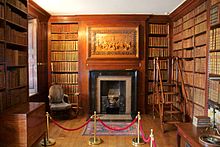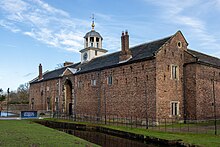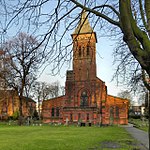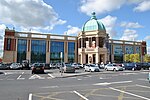Dunham Massey Hall
| Dunham Massey Hall | |
|---|---|
 | |
| Alternative names | Dunham Hall; Stamford Military Hospital |
| Website | |
| www | |
Listed Building– Grade I | |
| Official name | Dunham Hall |
| Designated | 5 March 1959 |
| Reference no. | 1356512 |
Dunham Massey Hall,usually known simply asDunham Massey,[1]is anEnglish country housein the parish ofDunham Masseyin the district ofTrafford,nearAltrincham,Greater Manchester.During World War I it was temporarily used as theStamford Military Hospital.
It was designated aGrade I listed buildingon 5 March 1959. It has been owned by theNational Trustsince the death of Roger Grey,10th and last Earl of Stamfordin 1976.
Dunham Massey was re-built in the early 18th century byGeorge Booth, 2nd Earl of Warrington.He had inherited an older mansion from his father, which was in a terrible state of repair.
There were significant alterations, especially internally, at the start of the 20th century. It has historicformal gardensand adeer park.The park and gardens are listed Grade II* on theRegister of Historic Parks and Gardens.
Location
[edit]Dunham Massey is anEnglish country housein the parish ofDunham Masseyin the district ofTrafford,nearAltrincham,Greater Manchester.[2]It was formerly in the ancientparishofBowdon,Cheshire.[3]
History
[edit]'Old' Sir George Booth, 1st Baronetbuilt the first mansion on the site in the early 17th-century.[4][5][6]However, the house remained uncompleted by the time of his death and was only completed after the Civil War in the later 17th century by his grandson,'Young' George Booth, 1st Baron Delamer.He inherited family debts, and spent a considerable amount of energy investing in the future of Dunham Massey Hall; he planted trees to sell for timber, and worked to recoup unpaid debts.[7]Themansion's service courtyard dates fromc. 1721.[2]The clock tower is inscribed with that date, suggesting that was when improvements were made to thestables.In the 1730s, John Norris was brought in to redesign the whole mansion bythe 2nd Earl of Warrington,with a design of brick façade accentuated by bays and a stone centrepiece.[8]
George Booth, 2nd Earl of Warringtondied in 1758, and in a move remarkable for the eighteenth century, ensured that his only child, a daughter,Lady Mary Booth(1704–72), would inherit and control the estate.[7]She married her cousin,Harry Grey, 4th Earl of Stamford(1736–68), whose family properties included his estate ofEnville Hall.Lady Mary oversaw the remodelling of the landscape at Dunham Massey, some of which, outside the park wall, that was reputedly undertaken byLancelot Capability Brown.[7]Their son,George Harry Grey, 5th Earl of Stamford and Warrington,inherited both Dunham Massey and Enville Hall, along with other properties. In the 1780s he commissioned a remodelling of the Great Gallery and the south front of the house by architectJohn Hope.He died in 1819, and his son, alsoGeorge Harry Grey, but the 6th Earl of Stamford and Warrington,inherited the estate and began to introduce modernisations to the house.[7]
The 6th Earl died in 1845, and his grandson,George Harry Grey,inherited and became the 7th Earl of Stamford. He married twice, first to Elizabeth (Bessie) King Billage, a shoemaker's daughter from Cambridge; the second to Catherine Cocks, a circus performer. However, the local gentry rejected his choices of wife, which led him to leave Dunham Massey and move to Enville Hall. The house was managed by Robert Cox, Catherine's nephew, and rented to tenants for periods in the subsequent fifty years.[7]The descendants of Catherine's niece Sarah Letitia Cox, still occupyEnville Halltoday.[9][failed verification]
The 7th Earl died in 1883, and his cousin, theReverend Harry Greyinherited the title of 8th Earl of Stamford, but never lived at Dunham. At the time of his inheritance, he was living in South Africa, having left England due to alcohol and gambling addictions.[7]He married three times: his first wife Susan Gaydon died in 1869; his second wife Annie Macnamara died in 1874.[10]His third wife,Martha Grey, Countess of Stamford,aKhoekhoewoman, was the daughter of a freed, formerly enslaved, woman.[11]She and the 8th Earl married in 1880. They had two children already, John and Frances, and their third, Mary, was born after they married.[12]Despite their marriage being recognised by South African law at the time, it was not recognised under English law. This meant that at the 8th Earl's death in 1890, his son, John, could not inherit, and the title passed toWilliam Grey, 9th Earl of Stamford,who was the nephew of the 7th Earl.[13]He inherited the title, but no assets, until the death of the 7th Countess, Catherine Cox, in 1905.[10]With his wife,Penelope Theobald,they led a programme of restoration for the house.[7]
The house was modified in 1905–1908 by architectCompton Hall,and by interior designerPercy Macquoid,in preparation for its reoccupation by William Grey, 9th Earl of Stamford. However, the 9th Earl died in 1910, just as the family was due to move in. Until these modifications, the southern front of the building had 11 three-storey bays; in order to make the building look more 17th-century in style, the third, fourth, eighth, and ninth bays were reduced to two stories withdormers,and a centrepiece of three bays was added, with columns each side of the central bay as well as stonepediments.[2]
William Grey died in 1910 and was succeeded by his son,Roger Grey, 10th Earl of Stamford,who donated the house, its contents, and the 3,000-acre (1,200 ha) estate to the National Trust at his death in 1976. At the time it was the trust's most generous bequest in its history.[7]
Stamford Military Hospital
[edit]
DuringWorld War I,Penelope Grey, Countess of Stamford, wife of the 9th Earl of Stamford, made the house available to theRed Crossas a military hospital, becoming known as the Stamford Military Hospital from April 1917 to January 1919. It hosted 182 injured soldiers who had suffered injuries and needed medical care, but not life-threatening, ranging from gas poisoning to bullets in the brain. Thehospitalwas run by Sister Catherine Bennett. Lady Stamford's daughter, Lady Jane Grey (laterTurnbull), trained as anurseat the hospital.[14][15][16]
From 1 March 2014 until 11 November 2016, the main ward at Stamford Military Hospital (known as "Baghdad" ), along with the operating theatre, nurses' station and the recreation room were recreated to commemorate the 100-year anniversary of the start of World War I,[15]along with actors playing the role of characters who worked, lived and recovered at the hospital.[16][9]
Collections
[edit]
Dunham Massey contains one of the most significant collections ofHuguenotsilver,largely collected byGeorge Booth,2nd Earl of Warrington.During his 64 years at Dunham Massey, he accumulated over 1000 pieces of silver. One sixth of the original plate remains at Dunham Massey, with much of the collection being dispersed by the Countess of Stamford and Warrington (who died in 1905), widow of George Harry Grey, 7th Earl of Stamford and Warrington (died 1883).[17]The10th Earl,Roger Grey,expended much money and effort in returning family heirlooms originally from Dunham Massey.[18]
There is a fine collection ofoil paintingsandwatercolours.Thereliefwood-carving of theCrucifixionbyGrinling Gibbons,which hangs in the Library, is the earliest known work by the 17th-century wood carver. It is on this piece of work he was working when he was discovered byJohn Evelynin 1671. A group of paintings of the house and estate, known as theHarris Views,showing the 1730s mansion, were described bySimon Jenkinsas "the most remarkable topographical survey of any country house and its grounds to remainin situ."There is also one painting is from 1690 by Adrien van Diest showing the earlier Elizabethan mansion. Another significant work in the art collection is anAllegory of TimebyGuercino.[19]

Alife-sized statueof an exoticised black man wearing only a skirt of feathers, in a kneeling position and holding asundialabove his head, was previously situated at the front of the house. It is believed to have originally been apersonificationofAfrica,produced by the sculptorAndries Carpentièreinc. 1735after a figure byJohn van Nostfor KingWilliam III's privy garden atHampton Court.[20]In June 2020, after numerous calls were made for theremoval of statues in Britain with links to the slave tradein the wake of themurder of George Floyd,the National Trust said that the decision had been made to move the statue.[21][22]
Other buildings
[edit]
The chapel has oak panelling, pews and reredos.[2]The silk wallcoverings in the chapel are a modern recreation, based on the original silk fabric, made in 2015–16.[23]The double courtyard house is built ofFlemish bondbrick, stone dressings, and a roof of Westmorland and Welsh slate.[2]
The Carriage House, south of the kitchen courtyard, is Grade I listed. It has aclock turret,which displays a date of 1721.[24]
Also south of the hall are the stable buildings, also Grade I listed. They probably date from 1721, but the west side was extended in the 18th century.[25]The Stables Restaurant is located in the upstairs of the South Stables, with an ice-cream parlour below.[26]
The oldest surviving building on the Dunham Estate is the watermill, possibly dating back to 1616. Originally built as a corn mill, it was later converted to a saw mill. It is Grade II* listed.[27]
Gardens and park
[edit]
It has historicformal gardensand adeer park.The park and gardens are listed Grade II* on theRegister of Historic Parks and Gardens.[28]The park is also aSite of Special Scientific Interest,based on the significance of its mature timber fauna.[29]The 300 acredeer parkat Dunham Massey dates back tomedieval times.[30][31]
As of 2012, the gardens housed over 700 plant species, as well as 1,600 trees and shrubs; it hosts the largest winter garden in Britain.[30]The Winter Garden has manysnowdrops,daffodilsandbluebells.[32]
During the Second World War, the eastern part of the estate was requisitioned for use first as a US Army camp and later repurposed asDunham Massey POW Camp.[33]
Listing and ownership
[edit]The stately home was designated aGrade I listed buildingon 5 March 1959.[2]It has been owned by theNational Trustsince the death of the10th and last Earl of Stamfordin 1976.[30]Over 439,000 people visited the site in 2020/21, making it one of the National Trust's top ten most popular sites; it was also the only site whose visitor figures increased during the COVID-19 pandemic.[34]
See also
[edit]Notes
[edit]- ^"Dunham Massey".National Trust.Retrieved21 February2016.
- ^abcdefHistoric England."Dunham Hall (1356512)".National Heritage List for England.Retrieved21 February2016.
- ^Dunn, F. I. (1987).The ancient parishes, townships, and chapelries of Cheshire.Cheshire Record Office, Chester Diocesan Record Office. [Chester]: Cheshire Record Office. p. 24.ISBN0-906758-14-9.OCLC59048208.
- ^"Booth, Sir George, 2nd Bt. (1622–84), of Dunham Massey, Cheshire. | History of Parliament Online".historyofparliamentonline.org.Retrieved12 July2022.
- ^Evans, David Morgan; Salway, Peter; Thackray, David (1996).The Remains of Distant Times: Archaeology and the National Trust.Boydell & Brewer.ISBN978-0-85115-671-2.
- ^Sambrook, Pamela (10 February 2006).A Country House at Work: Three Centuries of Dunham Massey.Pavilion Books.ISBN978-1-905400-19-5.
- ^abcdefghStubbs, Susie (2012).Dunham Massey, Cheshire: a souvenir guide.[England]. pp. 4–9, 55.ISBN978-1-84359-409-3.OCLC823893271.
{{cite book}}:CS1 maint: location missing publisher (link) - ^The National Trust (2000).Dunham Massey.
- ^ab"Bringing history to life".National Trust.Retrieved21 February2016.
- ^abSquires, Anthony E. (2002).The Greys: A Long and Noble Line: a Biography of the Family of Lady Jane Grey.Silk Press.ISBN978-1-902685-10-6.
- ^africanaunty (31 May 2015)."The Black Countess | South Africa Ancestors & Family Tree Research".Retrieved12 July2022.
- ^Ross, R. E. Van der (2008).The Black Countess: A Biography.Ampersand Press. p. 128.ISBN978-1-919760-75-9.
- ^"The Stamford Peerage: Sir George Grey's Cousin Successful".paperspast.natlib.govt.nz.Retrieved12 July2022.
- ^"Stamford, Earl of (E, 1628–1976)".Cracroft's Peerage.Heraldic Media Limited. 16 February 2008.Retrieved1 April2022.
- ^ab"First World War hospital to be recreated at National Trust's Dunham Massey Hall".1914. 5 November 2013. Archived fromthe originalon 16 March 2016.Retrieved21 February2016.
- ^ab"First World War Centenary: Dunham Massey Hall reconverted into a hospital".Independent. 4 March 2014.Retrieved21 February2016.
- ^Lomax, James; Rothwell, James (30 June 2006).Country House Silver from Dunham Massey.Pavilion Books. p. 127.ISBN978-1-905400-44-7.
- ^The National Trust (2000).Dunham Massey.pp. 29–30.
- ^Jenkins, 80
- ^Sundial,National Trust,retrieved13 June2020
- ^"'Degrading' Dunham Massey Hall statue removed ".BBC News.12 June 2020.
- ^Prior, David (10 June 2020)."Dunham Massey says it is" reviewing "a statue depicting a black figure carrying a sundial".Altrincham Today.Retrieved1 April2022.
- ^Newman, J.,Dunham Massey Hall Chapel Silk,Humphries Weaving, published 23 March 2016, accessed 19 May 2021
- ^Historic England."Carriage House immediately to south of kitchen courtyard (1067942)".National Heritage List for England.Retrieved21 February2016.
- ^Historic England."Stables to south of Hall (1356495)".National Heritage List for England.Retrieved21 February2016.
- ^"Eating at Dunham Massey".National Trust.Retrieved8 July2022.
- ^Historic England(5 March 1959)."Sawmill (Grade II*) (1067903)".National Heritage List for England.
- ^Historic England,"Dunham Massey (1000853)",National Heritage List for England,retrieved14 June2020
- ^Bradley, Jeremy (2017).The Old Park, Dunham Massey, Trafford, Greater Manchester: Archaeological Investigation and Participation Report(PDF).Oxford Archaeology.
- ^abc"A walk in the grounds of Dunham Massey".Guardian. 12 May 2012.Retrieved21 February2016.
- ^"A perfect parkland".National Trust.Retrieved21 February2016.
- ^"See the Garden spring to life".National Trust.Retrieved21 February2016.
- ^"Dunham Massey American Army & German POW Camp".Newsquest Media Group Ltd. Archived fromthe originalon 21 November 2010.Retrieved28 April2022.
- ^"National Trust Annual Report 2020/21"(PDF).National Trust. 2021. Archived fromthe original(PDF)on 8 January 2022.Retrieved12 July2022.
References
[edit]- Jenkins, Simon,England's Thousand Best Houses,2003, Allen Lane,ISBN0-7139-9596-3(gives 3 stars)
External links
[edit]- Burial sites of the Grey family
- Country houses in Greater Manchester
- Grade I listed buildings in Greater Manchester
- Grade I listed houses
- Grade II* listed parks and gardens
- Historic house museums in Greater Manchester
- Houses completed in the 17th century
- Medical museums in England
- National Trust properties in Greater Manchester
- World War I museums in the United Kingdom





